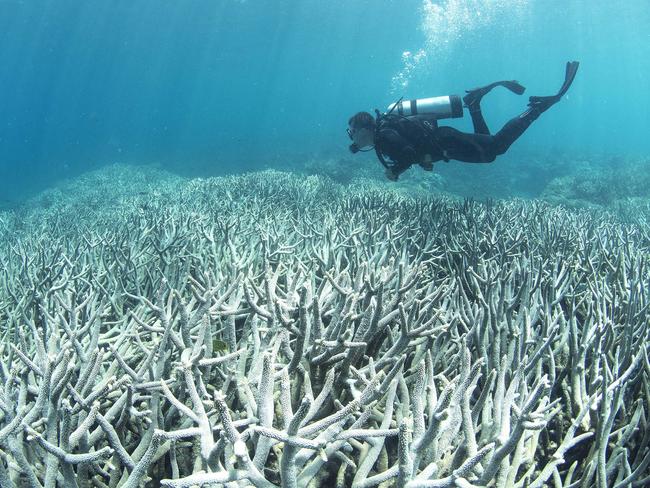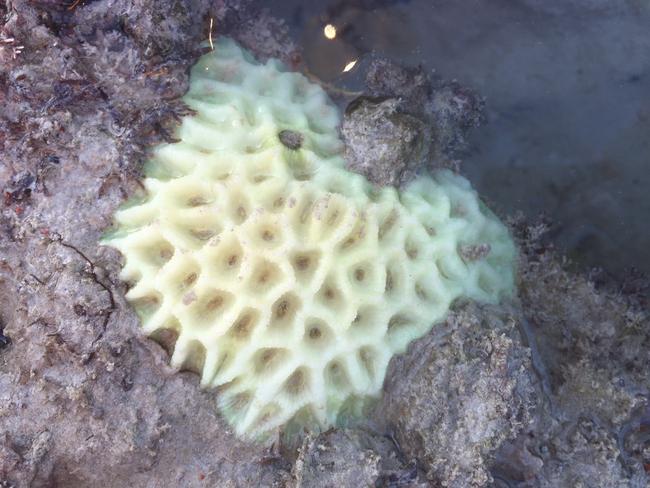Scientists sign an open letter demanding action on Great Barrier Reef
SOME Aussies are so desperate to be heard they’ve spent $14,000 to get their message across this week.

SCIENTISTS are so desperate to be heard they have signed a full page newspaper ad costing $14,000 to get their message across this week.
A group of 56 Australian scientists with more than 1200 years experience between them have warned this week that phasing out coal must be a top priority for Australia if the Great Barrier Reef is to be protected.
“We are now seeing first hand the damage that climate change causes, and we have a duty of care to speak out,” an open letter published in The Courier Mail stated.
The advert coincided with bleak news this week that the Great Barrier Reef was suffering its worst coral bleaching in recorded history. About 93 per cent of the World Heritage site is affected.
The scientists have called for the end of the fossil fuel era.
“Australia must rapidly phase-out our existing ageing and inefficient coal-fired power stations,” the ad states.
“In addition, there can be no new coal mines. No new coal-fired power stations. The transition to a renewables-led energy system, already underway, must be greatly accelerated.”
The Climate Council crowd-funded the money to pay for the ad, which a spokeswoman said cost $14,000.
“The ad was paid for by 250 Australians who donated specifically because they felt it was critical that Queenslanders understood the extent of the damage and the reasons behind it,” she said.
Queensland Environment Minister Steven Miles has demanded an urgent meeting of his interstate counterparts be convened to discuss climate change.

It comes as Australia’s Environment Minister Greg Hunt prepares to sign a global climate change deal in New York to limit global warming by at least two degrees.
But environmental activists want greater action from the government at home.
“Australians can see right through the hypocrisy of the government talking about the reef’s health while allowing the mining and burning of coal to go on at unprecedented levels,” Greenpeace Campaigner Nikola Casule said.
“Our reef is dying before our eyes. We need a credible plan to mitigate climate change and move to a coal-free economy,” he said on Friday.
This month the Queensland Government gave the go-ahead for Australia’s biggest coal mine, Adani’s Carmichael mine in the Galilee basin. It has been hugely controversial because its potential impacts on the reef due to dredging and increased port movements.
WWF Australia is calling on the government to commit to 100 per cent renewable electricity by 2035 and a plan to achieve net zero carbon pollution before 2050.
World-renowned reef scientist Professor Ove Hoegh-Guldberg, who signed the open letter, said that if the reef was in hospital, it’d be in ICU.
“It’s been distressing to see first-hand the severity and extent of damage from the bleaching event underway,” he said.

“This is one of the most visible icons of Australia — one of the world’s seven natural wonders and a multi-billion dollar economic asset.
“It is under threat and we must act now to save it. If we don’t, we will be explaining to our children and grandchildren that we had the chance to save this precious reef and we failed to take it.”
CORAL BLEACHING
After extensive aerial and underwater surveys, researchers at James Cook University said only seven per cent of the site had escaped the whitening triggered by warmer water temperatures.
“We’ve never seen anything like this scale of bleaching before,” said Terry Hughes, convener of the National Coral Bleaching Taskforce.
The damage ranges from minor in the southern areas — which are expected to soon recover — to very severe in the northern and most pristine reaches of the site which stretches along 2300km of the east coast.
Hughes said of the 911 individual reefs surveyed, only 68 (or 7 per cent) had escaped the massive bleaching event which has also spread south to Sydney and across the country to Western Australia.
“From Cairns to the Torres Strait, vast swathes of once-colourful reefs are now deathly white,” scientists warned in the newspaper ad.
WHAT HAPPENS IF WE LOSE THE REEF?
The reef generates about $5 billion in tourism income every year and employs nearly 70,000 people.
Daniel Gschwind, chief executive of the Queensland Tourism Industry Council warned against overzealous reporting that could create collateral damage in the tourism industry if tourists decided it was not worth visiting.
“Yes, the reef is under threat but it is still beautiful and it will become even more beautiful again when the recovery takes place,” he said. Many parts of the natural wonder were still in “excellent shape”.
Craig Humphrey, manager of the National Sea Simulator at the Australian Institute of Marine Science told news.com.au previously that there was a crucial need for data so economic activity could be balanced with protecting the environment.
“The only real way to do that is to provide really good quality data that enables the policy makers to make a valid decision,” he said.
“If that data doesn’t exist, then it’s really, really difficult to make the right decision.”

The SeaSim is conducting studies on both dredging and climate change impacts on the reef, but results will not be not be known for months, possibly years.
Federal Environment Minister Greg Hunt has admitted the coral bleaching is a “significant” event but has pointed to the government’s efforts to keep the reef off the World Heritage Committee’s “in danger” list and its long-term Reef 2050 plan as proof of its commitment to addressing the problem.
He did not say additional funding would be considered for reef rehabilitation.



